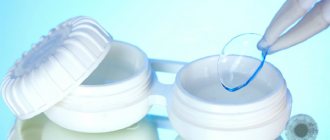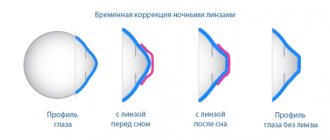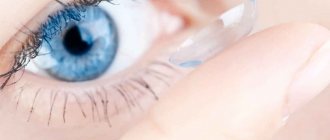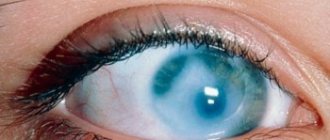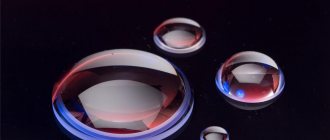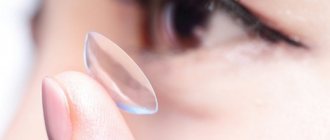Unfortunately, vision problems today concern not only older people. Increasingly, parents who are concerned about visual impairment in their child are turning to ophthalmologists. Computers, TV, mobile gadgets, poor-quality nutrition, aggravated by poor heredity, lead to an early decrease in visual acuity in a child. Also, cases of congenital anomalies in the development of the visual organs are increasingly being diagnosed. Just a few years ago, the only solution to the problem was glasses. Today there are safe, comfortable and effective contact lenses for children. They not only help the child see better and learn more effectively, but also have a corrective effect. Which ones are better to choose, how to use them correctly, at what age contact lenses are prescribed - read on.
When to start using
If a child has vision problems, the first question that parents have is whether children can wear contact lenses (CLs) and at what age. Ophthalmologists do not see any obstacles to the use of this method of vision correction by children and adolescents. Age is not a contraindication. This is not a drug that penetrates the blood and can affect the development of the child’s internal organs and systems.
It is much more important that children understand how important it is to maintain good hygiene when using contact lenses. A young patient must be old enough to be able to independently put on and take off lenses, wash them, and keep the container clean. If he is ready for this and understands all the responsibility, he can select lenses.
As medical practice shows, it is most advisable to prescribe the contact method of vision correction to patients starting from the age of 14. But if the defect is detected earlier, parents have every right to choose contact lenses for their child. There are cases when this method of vision correction is prescribed even to infants. But in this case, of course, all manipulations and care of the devices are performed by the parents.
Research has proven that even an 8-year-old child can fully master the skills of using contact lenses after 1–3 months.
The most important thing is to teach your child to use them correctly and care not only for the lenses, but also for all the auxiliary tools. Physically, a child’s eyes tolerate CL just as easily as an adult’s eyes, from a fairly early age. It has been tested and proven through experience that children from eight to eleven years old can easily cope with all procedures. Difficulties usually do not arise, but if problems do arise, you can always contact an ophthalmologist for additional advice or find the necessary information on the Internet.
Much depends on the parents. It is important not to repeat to the child: “You’re still small,” “You can’t handle it,” but to help him, gently remind him if he forgot to do something. Another important point that must also be taken into account when choosing children's contact lenses is the desire of the teenager himself to use them. He is the one who decides. Glasses have long been considered by young people as a trendy accessory, and not a reason for ridicule. Therefore, many teenagers, even with excellent vision, wear them every day. But if your child seriously suffers and has complexes from the fact that he has poor vision and is forced to wear glasses, there is every reason to think about switching to the contact method of vision correction.
For reference: according to statistics, eight out of ten children master the skills of using contact lenses within three months and use them as easily and automatically as a toothbrush or comb. Adults need almost the same period of time to adapt, so don’t underestimate a teenager’s neatness and organization.
Caution: Halloween Contact Lenses
Halloween contact lenses or colored contact lenses are for fun, especially for teenagers. If your teen is interested in purchasing colored or modern contact lenses, keep in mind that some may not be FDA approved. The exception is those cases when the products were purchased from the appropriate authorities that have special permits and certification for the sale of these goods.
Contact lenses are medical devices that are often recommended for vision correction for myopia and astigmatism. Lenses that are inappropriate or not prescribed by a specialist can harm a teenager’s eyes.
Additional information should be obtained from an ophthalmologist..
Indications
Only a doctor can prescribe CL to a child after an examination; under no circumstances should you do this yourself. The main indications are as follows:
Types of contact lenses for eyes
- Myopia (myopia) – today there are soft contact lenses that can correct myopia of any degree. But, unfortunately, they cannot stop its progression.
- Hypermetropia (farsightedness) - in comparison with glasses for farsightedness, lenses are much more physiological and safer. The child sees objects at a true distance in their true size, while glasses magnify and bring objects closer, which increases the risk of injury, especially on the street.
- Astigmatism – soft toric contact lenses make it possible to correct the defect up to 3 diopters.
- Anisometropia is the name given to a defect in which the refraction of the right and left eyes is different. If anisometropia is no more than two diopters, it can be successfully corrected with glasses; such a difference has almost no effect on the quality of life and visual acuity. If anisometropia exceeds three diopters, then the child begins to use the dominant eye, and the impulses of the weaker eye are suppressed and are not perceived by the brain. A birth defect usually causes the development of amblyopia. For high-grade anisometropia, it is advisable to use soft CLs for vision correction.
- Amblyopia – corrected by placing a patch on the stronger eye, or covering it with an occluder. School-age children do not agree to do this for obvious reasons. Contact lenses are invisible and can be used to successfully perform penalization: the better-seeing eye is artificially clouded, and thus amblyopia is treated.
- Aphakia – after removal of congenital or acquired cataracts, the optimal method of vision correction today is contact.
Any visual impairment in children and adolescents is an indication for the appointment of a contact method of correction
Contraindications to the use of CL are pathologies of the anterior segment of the eye.
Lenses for teenagers: main advantages
Many teenagers want to wear contact lenses. They provide high quality vision and do not limit freedom of movement at all. Contact correction products are convenient when playing sports because they do not compress the bridge of the nose and do not fog up in unfavorable weather conditions. Unlike glasses, they eliminate the appearance of aberrations (distortions) of the image, since they guarantee good quality of peripheral vision. In addition, clear contact lenses are invisible to the eyes and therefore do not attract the attention of others. This is very significant, since the attitude of adolescents towards their own appearance largely determines their self-esteem. The need to wear glasses for farsightedness, myopia and other refractive errors can provoke the development of complexes and self-doubt. Therefore, contact correction devices are the optimal solution to vision problems for schoolchildren, as well as older young people.
Pros of wearing lenses for teenagers:
- Provides high clarity of vision;
- Do not restrict freedom of movement;
- Eliminates image distortion;
- They do not squeeze the bridge of the nose and do not fog up in rain, fog, etc.;
- Allows you to exercise comfortably;
- They do not change their appearance and do not attract the attention of others.
How to select a lens
The selection of contact lenses for children is carried out only by an ophthalmologist. If a child used glasses before deciding to use contact lenses, do not immediately abandon them. He will not be able to adapt to contact lenses in one day, and glasses will still come in handy.
The doctor will conduct a full examination of the little patient’s vision and try on several different lenses before choosing the final, most optimal one.
Changing attitudes towards the selection of contact lenses for children
According to a 2010 study by the American Optometric Association (AOA),1 more than half of the optometric professionals surveyed—51.2%—believed that children are the best candidates for initial soft contact lens fitting. aged 10 to 12 years, 23.6% of respondents agree that these are children from 13 to 14 years old, and 12.4% believe that contact lenses should be selected for children already at the age of 8-9 years, and 11, 9% are confident that contact lenses can be prescribed to children under 8 years of age (Fig. 11).
Rice. 1. Experts’ opinion on children’s age most suitable for the initial selection of soft contact lenses
Recently, specialists in the field of optometry are increasingly prescribing contact lenses to their young patients as the main means of vision correction, and glasses as a secondary means. Contact lenses are a highly desirable form of vision correction for most children for a number of reasons. They not only save children from the sticky nickname “bespectacled”, but also have properties that are important for the full development of children’s vision and, in general, for the general physical development of a child or teenager, since they:
- do not limit the peripheral field of vision, do not distort the actual size of objects and the distance to them, thereby not complicating spatial orientation;
- do not fall out of sight, providing greater freedom of movement;
- are not traumatic.
According to the study mentioned above, of the 576 optometrists surveyed, 21% said they were now more willing than a year ago to prescribe contact lenses to children aged 10 to 12 years as their first choice for vision correction. Two thirds of respondents (49%) began to recommend contact lenses for this purpose to adolescents aged 15-17 years.
How can we explain the transition of specialists involved in children’s vision correction to contact lenses? For 29.5% of respondents, the decisive factor was the emergence of daily replacement lenses, for 23.3% - the development of more advanced materials for contact lenses with a high degree of wettability, low elasticity modulus, high oxygen transmission, etc.; 19.2% of respondents began to more often select contact lenses for children due to increased requests for this from young patients or their parents. Finally, for 10.3% of specialists, the basis for making a decision in favor of contact lenses were the positive results of recent studies in the field of correction and control of myopia using contact lenses in children, and for 9.6% - the high physical activity of children, their participation in sports competitions (Fig. 2).
Rice. 2. Reasons why specialists have become more willing to select contact lenses for children
Which lenses should you choose?
- For very young children, doctors recommend daily lenses. This is due to the fact that they do not require any care, container, solution or tweezers. They do not need to be washed or cleaned. The child puts on lenses in the morning and throws them away in the evening. But not all parents can afford such costs. Cost is the only disadvantage of such lenses.
- As an alternative, lenses for fourteen or thirty days can be used - and this is the best option. In a month it will be clear whether the child is able to care for them in compliance with all hygiene rules or not. If everything is in order, you can continue to use them. If difficulties arise, that’s also okay - compared to six-month lenses, thirty-day ones don’t cost that much.
- For children over 14 years of age, after testing one-day or thirty-day lenses, long-term lenses can be recommended. But in this situation, the risk of infection in case of violations of hygiene rules increases significantly. A teenager should always have moisturizing eye drops, a spare container and tweezers with him.
The selection of lenses in the ophthalmologist's office is carried out in several stages.
- First, the doctor will examine the outer part of the child's visual system using special equipment. This is necessary in order to completely eliminate direct contraindications to the use of CL.
- Next, all the necessary parameters of the visual organs are determined in order to select the optimal trial lens. The doctor will measure the diameter and curvature of the cornea and determine the degree of visual impairment. After this, lenses for testing will be selected.
- Then the specialist will help the child put on the lens and check the visual acuity in it. It is important to determine exactly how clearly the child sees, whether there are any distortions, and whether he feels discomfort. You will need to try on several different lenses to choose the most suitable one.
In conclusion, the doctor will tell parents and the little patient in detail how to properly use and care for contact lenses. The child will need to demonstrate how to remove and put on the lens independently so that the doctor can make sure that the information has been learned. If you have any questions, you should immediately contact your ophthalmologist. If everything is in order, then scheduled examinations and consultations are carried out every six months. In the first six months, it is recommended to visit an ophthalmologist before each scheduled CL change to monitor visual acuity and eye condition.
Can children wear colored lenses?
When deciding at what age children can use decorative optics, most ophthalmologists suggest parents rely on the seriousness of the child himself. Objectively speaking, color and tint models are not much different from the usual corrective lenses. Of course, there are certain differences between them. For example, beauty models are made mainly on the basis of hydrogel polymers, which perfectly moisturize the cornea, but at the same time do not transmit oxygen to it well enough. It is very important that the child understands that when using optical products it is necessary to follow certain rules, namely:
- use them for a certain period of time;
- put on and take off only with previously washed hands;
- treat with a disinfectant solution after wearing;
- store in a special container at night.
If your child has previously used lenses, for example, to correct myopia, then it will be easier for him to get used to wearing colored models, since he is already familiar with the basic rules for using optical products.
Models for children
The same types of CL are offered for children as for adults. First of all, all lenses are divided into soft and hard. Rigid gas-permeable lenses are prescribed to children in extremely rare cases. They are usually needed if soft contact lenses do not provide the desired effect, for example, with severe myopia or keratoconus. Hard lenses require a long adaptation period; they are felt on the eyes. The only benefit for baby and parents is that they can be worn for six months or more.
Children are usually prescribed soft CLs; the ideal, modern and safe option is silicone hydrogel, daily or with scheduled replacement after 14–30 days
Most often, soft CLs are selected for children. Modern models are made from silicone hydrogel. They are highly breathable, which is important for comfort and eye health. The characteristics of conventional hydrogel lenses are slightly different, but they also do their job well and are well suited for children's eyes.
As for the duration of wearing, it was already mentioned above that the ideal option would be contact lenses with frequent scheduled replacement (from 14 to 30 days) or daily lenses. Don’t think that you can save money by buying a pair of lenses for six months at once.
- Firstly, with use, the optical characteristics of the lens will deteriorate.
- Secondly, deposits will accumulate on the lens, which increases the risk of infection of the visual organs.
- Thirdly, the child may simply lose them or tear them in just two weeks, and he will have to buy a new pair and spend even more.
Whatever type of lenses you choose, you cannot wear them all day long. The child's eyes, blood vessels, optic nerve and receptors must get used to the new perception of the world around him. Therefore, adaptation occurs gradually. On the first day, the lenses are worn for two hours. Then they need to be removed and put on again a day later, now for three hours. And so on until 12 hours are reached. If you rush, you can get unwanted side effects:
- headache;
- increased intracranial and intraocular pressure;
- visual impairment;
- eye irritation.
The adaptation period has its advantages: during this time you can master the skills of using contact lenses, because the child will regularly put them on, then take them out, wash them and put them in a container.
Which lenses are best for children?
Children are usually prescribed soft daily contact lenses or frequently scheduled replacement lenses (replacement every 1 month or more frequently).
Daily lenses do not require any care: you put on a fresh pair in the morning and throw them away in the evening. In addition, daily lenses are considered the healthiest and safest for the eyes. Therefore, they will be the best choice for children, especially for small ones.
Contact lenses with frequent scheduled replacement require daily care, and they can be worn by those children who are responsible enough to carry out all daily procedures for caring for them.
It is better for children not to wear contact lenses for a longer period of time (3-6 months), since as the duration of wear increases, deposits are deposited on them, the lenses become uncomfortable, their optical characteristics deteriorate, and the likelihood of infection increases.
Traditional contact lenses (replacement after a year or less) are not prescribed to children (as well as adults) in European countries at all. No one there wears the same soft lenses for so long. Wearing lenses for more than 6 months is permissible only for rigid gas permeable lenses (RGP).
ZGP lenses are usually prescribed to children in quite rare cases when soft lenses cannot provide the desired effect (for example, with keratoconus or with very severe myopia). ZhGP lenses require a period of getting used to, since when they are first put on they are not comfortable enough (the eye feels them like a foreign body). Most children wear soft contact lenses.
Currently, there is a very wide selection of different contact lenses made from different materials. The most modern type is silicone hydrogel lenses.
Silicone hydrogel contact lenses provide a very high level of oxygen transmission to the cornea of the eye, which is necessary for maintaining eye health.
However, in the family of hydrogel lenses there are many excellent modern lenses that a child can safely wear.
Can wearing lenses stop the deterioration of a child's vision?
Unfortunately, children in school (and later in their student years) often experience constant deterioration in vision (myopia develops), and they require increasingly “strong” lenses to correct their vision (i.e. lenses with an increasing number of “minus” diopters ).
Experts call heavy visual load at close distances one of the main factors causing the development of childhood myopia: children have to write or read a lot during their school years.
Most experts believe that wearing soft lenses cannot slow the development of myopia in children.
As for rigid gas permeable contact lenses, experts associate certain hopes for the possibility of slowing the progression of myopia in children with orthokeratological contact lenses (these are rigid lenses that are not worn during the day, but put on at night).
Research into the use of orthokeratology lenses to slow the progression of myopia in children is ongoing.
Let us note that in recent years, another direction has emerged in solving the problem of slowing the development of myopia in children. Scientists from Australia and the USA have put forward a new theory of inhibiting the development of myopia and, in accordance with this theory, have developed a special design for lenses that should slow down this process.
The patent for this special lens design is held by Ciba Vision. So far they have not appeared on the optical market.
Can children wear lenses without removing them at night for a long time?
There are now a number of soft contact lenses that can be worn overnight for up to 30 days. However, most specialists refrain from prescribing continuous wear lenses to children without necessarily removing them at night.
[direct2]
This is due to the fact that for this wearing mode the risk of complications is higher than when wearing them during the day (i.e., with the obligatory condition of removing them at night). Doctors strive to minimize the risk of children developing any complications when using lenses.
If for any reason parents insist on such a regimen for their child, they should discuss the possible risks with the doctor and ensure that the child strictly follows the doctor's recommendations for wearing continuous wear contact lenses.
What is the role of parents when their child wears lenses?
Parents play a very important role in ensuring their child wears lenses safely. Parents are the actual “second” patient when the doctor matches their child. They must know all the rules for wearing, handling and caring for contact lenses.
Parents should constantly monitor their child in terms of compliance with the rules for using lenses. Parents must monitor the condition of the child’s eyes and at the slightest suspicion of a deviation from the normal condition (“red eyes”, etc.) or the child complains of any problems with the eyes, ask the child to immediately remove them and contact an ophthalmologist as soon as possible .
With the correct choice of contact lenses and if the child (under the constant supervision of parents) follows the rules of wearing and caring for them, children can safely use this convenient method of vision correction not only during their school years, but also in adulthood.
Source https://www.optica4all.ru/index.php?option=com_content&view=article&id=1669&Itemid=384
Why you should give preference to CL
Children and adolescents are very vulnerable; relationships with the outside world, in particular with peers, are extremely important for them. A child wearing glasses can become an object of ridicule in the classroom and on the playground. Therefore, most children are embarrassed to admit they have vision problems at an appointment with an eye doctor. And when the defect does open (this inevitably happens sooner or later), they flatly refuse to wear glasses. Contact lenses for children become a real salvation in such cases.
The most important advantage is that a child wearing contact lenses gets much more freedom for active movement without the risk of injury than wearing glasses.
A number of advantages can be highlighted:
- The child gets the opportunity to freely play active games, play sports, and attend various sections and clubs. Children are very mobile, and glasses can easily break during a game of ball or hide-and-seek, during sports training and injure the baby. With CL there is nothing to worry about.
- The lenses do not narrow the field of view, and the contrast and clarity of the visual image will be much clearer.
- CLs increase a teenager’s self-esteem. He does not have complexes in front of his peers, he feels confident and complete.
- Lenses correct vision rather than worsen it, unlike glasses. After a year, your child's vision will remain at the same level or even improve, and you will not need to select a new corrective device.
- Even if the lens is lost, you can purchase a new one the very next day without any problems, and it will be cheaper than ordering and buying new glasses.
- Vision correction is carried out constantly. Many children deceive their parents and take off their glasses as soon as they leave the house. This will not happen with CL.
If you still have doubts about whether or not you should switch to contact lenses, an American experiment can help you decide. Several years ago, when CL began to gain popularity, scientists in the United States conducted studies among high school students. The results of the experiment were shocking. Those children and adolescents who wore glasses for a long time, after switching to contact lenses, began to study better, their self-esteem increased and their relationships with peers improved. The positive changes were especially noticeable in girls.
Contact lenses and physical activity
If a teenager is actively involved in sports at school or is a member of any sports team, CLs can make life easier, while perfectly performing their main function - vision correction. Here it would be appropriate to compare glasses and lenses and see how good the latter are in sports:
- Avoiding broken glasses will eliminate the worry of injury and the expense of repairing or replacing the product.
- There will be no more sliding or falling glasses during a game or practice.
- Contact lenses do not limit the field of vision, providing optimal peripheral vision.
- You can wear safety glasses with contact lenses (an essential accessory in some sports).
What else do you need to know
The contact method of vision correction helps to easily solve a number of problems if a teenager is diagnosed with nearsightedness, farsightedness or astigmatism. But it also has its drawbacks. The most important thing is the risk of infection of the organs of vision. Children find the process of removing and cleaning lenses every evening tedious and boring; they try to complete it as quickly as possible, so they often clean the lens poorly. If this happens regularly, sooner or later the eyes will become inflamed and conjunctivitis will develop.
Is it forbidden for children and adolescents to wear colored contact lenses - a question frequently asked to ophthalmologists
Sometimes teenagers simply forget to take out CLs at night and fall asleep in them, which is also undesirable. If this happens regularly, it makes sense to return to glasses for a while, and later repeat the experience with lenses. Many parents purchase both for their child. At home the child uses glasses. And if you need to go outside, to train, etc., put on contact lenses.
Is it possible for children and teenagers to wear colored CLs? Another question often asked by parents. More precisely, he is interested in girls aged 13–17 years who like to experiment with their appearance. Colored contact lenses are no different from regular lenses in their characteristics. But they cost an order of magnitude more. And it is not always possible to select color contact lenses of exactly the diopter that is necessary for vision correction.
Summary: Vision problems today arise from a very early age in children and adolescents. Despite modern methods of vision correction and restoration, this is not always possible. To stop the progression of myopia, farsightedness, and astigmatism, special children's contact lenses are selected. They are invisible to others, simple and comfortable to use, reliable, safe, accessible and enable the child to lead a full life along with his peers. The main thing is to find a good specialist and choose the optimal lenses.
Child-Friendly Contact Lenses
The above survey also showed which characteristics of contact lenses, according to experts, are the most significant when it comes to children. For all respondents without exception (100%), it was important whether contact lenses provide high visual acuity, then - ease of putting on/removing lenses and high oxygen transmittance Dk/t (99%), comfort (98%), as well as mode wear, or frequency of lens replacement (96%). In addition, a significant factor was the lens's provision of protection from harmful ultraviolet (UV) radiation. This factor influenced the decision that these lenses were acceptable for fitting to children in 75% of cases (see table).
Experts’ opinion on the degree of importance of certain properties of contact lenses, %, when selecting them for children | ||
| Lens property | Very important | Medium importance |
| Comfort | 75 | 23 |
| Oxygen transmission rate | 64 | 35 |
| Ease of manipulation | 53 | 46 |
| Optical properties | 53 | 47 |
| Replacement frequency | 47 | 49 |
| UV protection | 30 | 45 |
As mentioned earlier, for the majority of specialists surveyed, who began to more often select contact lenses for children, a significant argument in favor of this was the emergence of daily disposable lenses (Fig. 3). These daily disposable lenses include SofLens daily disposable (Bausch + Lomb), which are great for both children involved in sports and simply active children. With an improved aspherical design, these lenses eliminate spherical aberrations and provide clear vision, especially in low light conditions. In addition, the optimal thickness of SofLens daily disposable lenses and their constant moisture ensure their comfortable wearing throughout the day.
Rice. 3. A number of daily and biocompatible contact lenses acceptable for selection for children include
Contact lenses acceptable for children also include silicone hydrogel daily lenses 1-Day Acuvue TruEye (Johnson & Johnson Vision Care), which are fully suitable for use during sports and active games. These lenses are made of a unique material, Narafilcon A, which includes a silicone polymer that promotes high oxygen transmission to the cornea (Dk/t = 118 units). Thanks to this, the child’s cornea’s need for oxygen is satisfied 100%, which is a significant factor, since the body consumes more oxygen during physical activity. It is also important for children who spend a lot of time outdoors that the 1-Day Acuvue TruEye lenses have a reliable UV filter that protects their eyes from the harmful effects of ultraviolet radiation: 99% from UVB rays and 97% from UV rays - A- rays.
The new generation Focus Dailies AquaComfort Plus (CIBA Vision) daily contact lenses are also well suited for children. The AquaComfort technology used in them contributes to the comfortable wearing of these lenses and prevents the feeling of dryness. The moisturizing effect is achieved thanks to a special component embedded inside the lens, which is gradually released and moisturizes the lens with every blink. In addition, Focus Dailies AquaComfort Plus lenses are very easy to put on and take off. They are produced using a sterile, high-precision process to ensure they are of high quality and safe to wear.
Further, among the contact lenses acceptable for children is the newest development in the segment of one-day silicone hydrogel lenses - Maxima 1-Day Premium. These lenses combine high moisture content, which means comfort for the user, and high oxygen transmission, which is important for children's eyes. Thanks to the aspherical design, Maxima 1-Day Premium lenses provide the child with clear contrast vision and full color perception. The special design of both surfaces of the lenses not only simplifies their selection, but also promotes a stable fit on the cornea of children and adolescents, which is of great importance when playing sports and outdoor games.
Biocompatible planned replacement lenses of the Proclear family are also widely used when working with children, which include spherical lenses Proclear Sphere, one-day Proclear 1-day, toric Proclear toric and multifocal Proclear Multifocal. These contact lenses are made using unique PC technology, thanks to which they provide children's eyes with ideal hydration and excellent comfort even in conditions of low air humidity, during the child's physical activity and high visual concentration during games.

